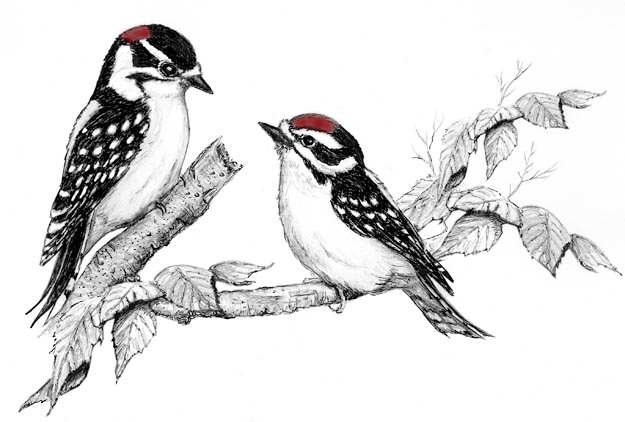
Dear Bird Folks,
Please take at look at the attached photograph and tell me what kind of woodpecker it is. It looks very much like a Downy Woodpecker, but instead of having the red patch on the back of its head, it has red on its forehead. I can find no images of this bird in my bird book. Is there something wrong with the woodpecker or is there something wrong with my bird book?
– Justin, Cheswold, DE
Yes, yes, yes, Justin,
Well, first, no, no, no. There is nothing wrong with that woodpecker. It is supposed to look like that. However, there is something wrong with your bird book. It’s incomplete. Books that don’t show all the birds are one of my biggest complaints, and I have a lot of complaints. Deficient books are right behind my two top complaints, which are (thanks for asking) the foolishness of using mixed birdseed, and any statements made by executives of British Petroleum. Using a bird book that doesn’t show all the birds is like trying to assemble a barbeque set that doesn’t include all the parts. It’s maddening. (Although, the barbeque thing can be entertaining for anyone watching you.)
The bird in your photo looks like a Downy Woodpecker because it is a Downy Woodpecker; it just happens to be young downy. For the first few months of its life, a male downy has red on its forehead instead of its nape. I don’t know why, perhaps it’s a fashion statement. After a molt, which takes place at the end of the summer, the red patch on the young male moves from the front of the head to the back. After that, the kid looks more like his old man. Young female downies don’t have the telltale red patch, but they can be told from the adults by their bright, shiny feathers. Their tired, old parents don’t look that pretty. After pushing themselves through the nest hole hundreds of times in order to feed their hungry chicks, the adults’ outfits can become dingy, worn and stained. Sounds like the clothes I wear everyday of the year.
Another bird lots of people become confused about in summer, which also doesn’t appear in those dreaded incomplete field guides, is the young Northern Cardinal. The signature feature of a cardinal is its bright red beak. However, for the first few weeks of their lives, young cardinals have dull black beaks, which can confuse the casual birder. Not to worry. As the weeks pass, the youngsters’ beaks slowly change color. By the end of the summer, the young birds will have red beaks, just like the adults. And while we are talking about odd-looking cardinals, a few cardinals (and some jays, too) have an unusual molting pattern. These strange molts cause the birds to lose all of their head feathers at one time. This process exposes their black, naked heads, making them appear to be bald. But once again, not to worry. Their head feathers will grow back, so there is no need to call me, knit them tiny hats or add Rogaine to your birdseed.
Another common but odd-looking bird of late summer is the young male Brown-headed Cowbird. When the males leave the nest, their plumage is a dull, washed out, khaki color, looking like the clerks at L.L. Bean. As the summer wears on, the bodies of the males change from khaki to glossy black. It would be nice for new birders if the cowbird’s transformation happened all at once, but that would make things too easy. For a few weeks, the male cowbird’s plumage is a strange quilt of brown and black patches, looking like the roof of a Cape Cod house after a November storm.
Even those ubiquitous American Robins can be tricky to identify during their first summer. Although they don’t look like it, robins are thrushes. Adult robins don’t have the typical thrush spotting but their kids sure do. For the first few weeks of their lives, robins are awkward and speckled, like a teenager with acne.
Here’s a bird that gets me into at least one argument a week: Red-tailed Hawks, which don’t always have red tails. For their entire first year, their tails have brown and white barring. This fact doesn’t sit well with the folks who have just seen a huge bird eat a squirrel in their backyard. They think it was an eagle. When I suggest that it was more likely a Red-tailed Hawk, they shoot back, “No way! It didn’t have a red tail.” In their mind any large bird of prey without a red tail must be an eagle. And speaking of eagles, contrary to what some people think, not all brown eagles are Golden Eagles. First year Bald Eagles are basically large brown birds; they don’t get their trademark white head and tail until the age of four. Here in the East any large, brown eagle-sized bird is most likely a young Bald Eagle. That’s just the way it is, so stop arguing with me. I don’t make the rules.
Thanks for the picture of the young Downy Woodpecker, Justin. You have a good eye. You noticed something others often don’t, including the clowns who wrote your bird book. They either didn’t notice that adult and young woodpeckers look different or they simply chose to ignore reality. Ignore reality, eh? They could work for BP.